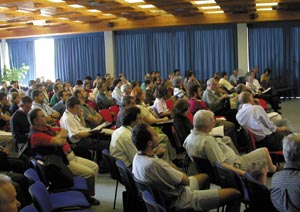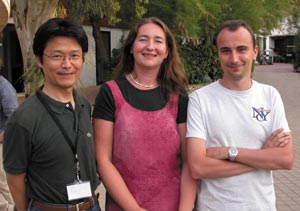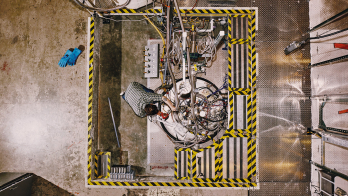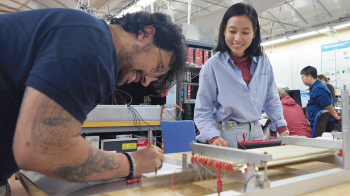Giorgio Chiarelli reports from the 9th Pisa Meeting on Advanced Detectors, held this year on the island of Elba.

The final week of May saw the traditional gathering of the Frontier Detectors for Frontier Physics Conference (FD4FP) at the 9th Pisa Meeting on Advanced Detectors. The meeting was the sixth to be held on the island of Elba, and more than 300 participants – including physicists and representatives of the high-tech industries involved in the R&D of high-energy particle physics – discussed the latest results from the work that lies at the core of experimental particle physics: the design, building and running of particle detectors.
The 250 oral and poster contributions were divided among seven sessions covering different aspects of the field: calorimetry, tracking with solid-state devices, tracking with gaseous detectors, detectors for fundamental physics and astroparticle physics, front-end electronics, trigger and data acquisition, and particle identification. As has been the case for many years, a special session was also devoted to the application of particle detectors and particle-physics techniques to other fields.
The first day – opened by Lello Stefanini of Pisa, chairman of the FD4FP Executive Board, and Umberto Dosselli of Padova, on behalf of the International Advisory Committee – saw Richard Wigmans of Texas Technical summarize the current state of detector R&D. Wigmans stressed the growing importance of the use of particle detectors in other fields, first and foremost in astroparticle physics. This is a trend that is not only supplying different areas of research with new tools, but that also provides new challenges for detector builders. Guido Altarelli of CERN presented a clear view of the physics that lies ahead, that is, the basis for R&D in the field. Looking to the future, Les Robertson of CERN discussed the prospects and needs of computing in the era of the Large Hadron Collider (LHC), and also described the aims and status of the Grid. Rolf Heuer of Hamburg brought the audience up to date with worldwide initiatives and new ideas about the linear collider and how it can be established as a global project.
Whilst it is almost impossible to summarize a week full of presentations and discussions, and give proper recognition to everyone, a selection of the contributions should give a flavour of the topics discussed. For example, in the Gas Detectors session, Werner Riegler from CERN presented a detailed study of the behaviour of resistive plate chambers. By going back to the drawing board and slowly but carefully studying space charge effects, he showed how a suppression factor of 107 for the collected charge can be explained in these devices.
Talks on experiences with large solid-state detectors highlighted the obstacles to be overcome when running such devices. Contributions by BaBar and CDF showed that only ingenuity, dedication and a continuous R&D effort can provide “smooth” data taking, as the unexpected (to be understood as the “not thought of”) is always round the corner! As Brian Petersen of Stanford described, the excellent performance of the BaBar vertex detector is due to daily dedication as well as vigorous R&D. In this context, it was a pleasure to listen to William Ashmanskas of Chicago describe the excellent performance of the CDF trigger on secondary vertices – a device first presented at the Pisa Meeting in 1984. This provided an encouraging message for the LHC groups who are now building astonishingly large detectors that will shed light on the Higgs particle and other new physics.
R&D is the cornerstone on which detectors are built, and Valeri Saveliev of DESY/Obninsk State showed how continuous efforts in the field of solid-state photomultipliers is now paying off. Ready-to-use devices are now available and provide a new tool for the physics of the future.
The quest for detectors for the new generation of experiments (both ground and space based) for astroparticle physics has found a response in the particle-physics community. At Elba, several presentations tackled the complex issues of the deployment of large and elaborate devices both on Earth and in space. From the well-advanced AMS experiment to be installed on board the International Space Station, to the Auger Observatory being built and commissioned in Argentina, the techniques born in high-energy physics are being used to unveil the secrets of the universe. The search for gravitational waves requires much more than Newton’s apple, and those commissioning the large interferometers Ligo and Virgo are already thinking ahead, as described by Riccardo DeSalvo from Caltech.

While the use of results from particle physics in medicine is a well-established tradition that began with X-rays, participants in the large conference room of Hotel Hermitage had the chance to find out about aspects of the application of particle-physics techniques in other fields. Roberto Pani of Rome presented the efforts involved in the transfer of technology from high-energy physics to industry (the Italian “IMI Project”), while Jean-Marie Le Goff from CERN explained the basics of such efforts. On a lighter note, Carl Haber from LBL showed how metrology and pattern recognition, developed to build the ATLAS vertex detector, can provide the opportunity to listen to old, invaluable recordings that might otherwise be lost forever.
R&D on detectors would not be so fruitful without the involvement of industry. Representatives from high-tech firms all over the world displayed their products in individual stands throughout the week and discussed their current and future projects in plenary sessions as well as private conversations.
For those who were unable to attend the conference, a live webcast was available and this can still be seen on the website at www.pi.infn.it/pm/2003, along with the full conference programme.








